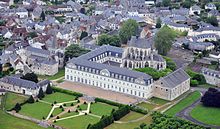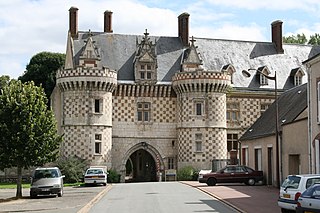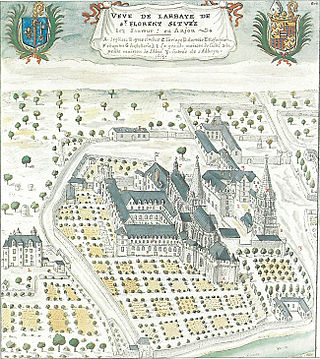

Pontlevoy Abbey is a former Benedictine abbey located in the town of Pontlevoy in the Loir-et-Cher department of France.


Pontlevoy Abbey is a former Benedictine abbey located in the town of Pontlevoy in the Loir-et-Cher department of France.
It was founded in fulfillment of a vow in 1034 by Gueldouin or Gelduin de Chaumont, a local knight. It is believed that Gelduin's boat was caught in a storm on the way back from a Crusade in the Holy Land. He prayed to the Virgin for help, promising to build Her a church in Pontlevoy, which he held as a vassal of the Count of Blois. Allegedly, the Virgin dressed in white, appeared above the rolling deck and calmed the sea. [1]
Gelduin endowed the abbey with enough revenue for Benedictine monks to build a huge church, dedicated to the White Virgin. From the east, it looks like a complete Gothic cathedral with flying buttresses and trefoil stone tracery in the windows of the radiating chapels. There is a gravel courtyard where the nave should be. [1] The monks treated the sick and educated children.
The church was almost completely destroyed during the Hundred Years' War. The monks rebuilt the apse and choir but couldn't afford to replace the rest. Inside, on the wall behind the altar, there is a little 11th-century statue of the White Virgin with her Child in her arms. The child leans against her left shoulder. She presses his left hand to her heart. The naif style indicates it was done by a local mason rather than a professional sculptor. The monks ran a hospital here, with a sanctuary for lepers, until the 16th century and also educated local children. But by 1623, when Cardinal Richelieu was named abbot, the monks had abandoned their vows and the buildings were in ruins. [1]
Richelieu repaired them in 1644 and brought in six Benedictine monks from the Congregation of Saint Maur. They started a seminary for the sons of the nobility and the rich bourgeoisie. Students came even from England. In 1776, Louis XVI turned the school into one of the 12 royal military academies of France; a huge cedar of Lebanon in the courtyard was planted in honour of his accession to the throne. [1] The military school was suppressed on the French Revolution but the college in the monastery was left open as a private secular institution, headed by a secularized Benedictine. [2] It was a boarding school with a conservative tradition; some families moved to Pontlevoy to be near their sons. The mid- nineteenth century director, Abbé Louis Alexis Bourgeois, conducted subsequently controverted research into prehistoric remains of the area. They built large, elegant houses with steep, slate roofs, walled gardens and spiked wrought-iron fences that still grace the town. The huge 18th-century building - three stories high with a mansard roof - resembles those government ministry buildings around the Palais Bourbon in Paris. The college housed German troops during World War Two and closed for a period of time after the War. [1]
The previous owner of the abbey and the college was the Marquis de Vibraye, a descendant of Gelduin, allowed Pontlevoy to open a municipal museum on the third floor. The first two rooms displayed a collection of 19th- and early 20th- century cards advertising Poulain Chocolates. The company, founded by Auguste Poulain, who was born in Pontlevoy in 1815, is still a major manufacturer in Blois. Poulain was a pioneer of modern advertising. Each year his company issued a new series of brightly colored cards commemorating notable men (including Benjamin Franklin) with flowers and illustrations of fairy tales. They were collected and traded throughout Touraine in the 19th century. [1]
In the 1980s there was a Museum of Heavy Trucks at the Abbey which was a project of the former mayor, Mr. Maffre. It included about 40 vehicles. Mr. Maffre's pride: a 1935 electric delivery van from the Poulain factory; a De Dion Bouton, from 1918, the oldest truck in the collection, and an American G.M.C. used by the Swiss army in 1942. [1]
The building was classed as a historic monument on 6 April 1934 and 19 April 1991. [3] It was bought in 2001 to house "The European American Center for International Education", whose aim is to promote and develop cultural exchange between Europe and the United States. This was closed in 2017. Since the end of 2018, it is used by the lycée catholique de Pontlevoy, a secondary school. [4]

Blois is a commune and the capital city of Loir-et-Cher department, in Centre-Val de Loire, France, on the banks of the lower Loire river between Orléans and Tours.

Vendôme is a subprefecture of the department of Loir-et-Cher, France. It is also the department's third-biggest commune with 15,856 inhabitants (2019).

The Tironensian Order or the Order of Tiron was a medieval monastic order named after the location of the mother abbey in the woods of Thiron-Gardais in Perche, some 35 miles west of Chartres in France). They were popularly called "Grey Monks" because of their grey robes, which their spiritual cousins, the monks of Savigny, also wore.

The arrondissement of Romorantin-Lanthenay is an arrondissement of France in the Loir-et-Cher department, in the Centre-Val de Loire region. It has 74 communes. Its population is 112,145 (2016), and its area is 2,670.9 km2 (1,031.2 sq mi).

Affligem Abbey is a Benedictine abbey in the municipality of Affligem, Flemish Brabant, Belgium, 19 km (12 mi) to the north-west of Brussels. Dedicated in 1086, it was the most important monastery in the Duchy of Brabant and therefore often called Primaria Brabantiae.

Fleury Abbey (Floriacum) in Saint-Benoît-sur-Loire, Loiret, France, founded in about 640, is one of the most celebrated Benedictine monasteries of Western Europe, and possesses the relics of St. Benedict of Nursia. Its site on the banks of the Loire has always made it easily accessible from Orléans, a center of culture unbroken since Roman times. In 2010, the abbey had over forty monks led by the abbot Etienne Ricaud.

Solesmes Abbey or St. Peter's Abbey, Solesmes is a Benedictine monastery in Solesmes, Sarthe, France, and the source of the restoration of Benedictine monastic life in the country under Dom Prosper Guéranger after the French Revolution. The current abbot is the Right Reverend Dom Abbot Geoffrey Kemlin, O.S.B., elected in 2022.

The Abbey of Saint-Georges-du-Bois is a recently re-established Benedictine monastery at Saint-Martin-des-Bois, a commune in the canton of Montoire-sur-le-Loir and the arrondissement of Vendôme, in Loir-et-Cher, France.

La Trappe Abbey, also known as La Grande Trappe, is a monastery in Soligny-la-Trappe, Orne, France. It is known for being the house of origin of the Trappists, to whom it gave its name.

Pontlevoy is a commune in the Loir-et-Cher department, central France.

Bourgueil Abbey was a Benedictine monastery located at Bourgueil, historically in Anjou, currently in Indre-et-Loire and the diocese of Angers. The founder was Emma of Blois, daughter of Theobald I of Blois, and by her marriage, duchess of Aquitaine.

Valmagne Abbey is a former Benedictine monastery located near Villeveyrac, Hérault, in south-central France. It is a designated historic monument.

Bonneval Abbey, also known as St. Florentinus' Abbey, is a former Benedictine monastery in Bonneval, Eure-et-Loir, in France.

Charroux Abbey is a ruined monastery in Charroux, in the Vienne department of Nouvelle-Aquitaine, western France.

Valmont Abbey is a Benedictine abbey in Valmont, Seine-Maritime, France. Its chapel and surviving ruins of other parts of the abbey were classed as historical monuments in 1951 and the facades and roofs of all the abbey buildings were made historic monuments in 1965.

Moissac Abbey was a Benedictine and Cluniac monastery in Moissac, Tarn-et-Garonne in south-western France. A number of its medieval buildings survive including the abbey church, which has a famous and important Romanesque sculpture around the entrance.

The Abbey of Saint-Florent, Saumur, also Saint-Florent-lès-Saumur or Saint-Florent-le-Jeune, was a Benedictine abbey in Anjou founded in the 11th century near Saumur, France. It was the successor of the Abbey of Saint-Florent-le-Vieil which was abandoned by its monks during raids of the Vikings.

L’Aumône Abbey is a former Cistercian monastery in the commune of La Colombe, Loir-et-Cher, France, 34 kilometres north of Blois in the Forêt de Cîteaux, part of the Forêt de Marchenoir.